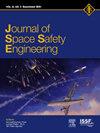太空骑士的首次飞行有效载荷/实验安全验收过程
IF 1.7
Q3 ENGINEERING, AEROSPACE
引用次数: 0
摘要
作为太空骑士任务的一部分,实验将有机会在轨道上度过大约两个月的时间。实验的类型差异很大,导致高度多样化的风险,需要在单个有效载荷水平、总体水平和太空骑士的再入模块水平进行管理,以确保各级任务的成功。此外,由于该任务将从法属圭亚那发射,太空骑士任务将通过基于两个方面的提交程序从法国当局获得发射授权。首先,展示了对任务产生的危险的正确识别和管理,其次,展示了对法国各项条例和欧空局空间碎片缓减规则的遵守情况。由于太空骑士的首飞可能会进行至少14个实验,为了简化整个授权过程,方便实验安全输入的提供,我们根据每个实验的危险性采取了简化的方法。首先,通过执行这种简化的方法,似乎有几个实验呈现非常相似的危险,因此允许向所有实验所有者提供同质的设计建议和要求。此外,它可以根据以前与类似实验的交流,向潜在的新实验所有者提供明确的反馈。其次,通过将焦点几乎完全放在危险超过预先确定的严重阈值的实验上,这种简化的验收过程通过减少工作量来节省时间。这使得能够与负责对法属圭亚那航天中心条例[3]进行太空骑士安全评估的法国当局进行更快和更简洁的通信。最后,通过从一开始就综合所有实验的风险,它需要与所有潜在的实验所有者进行早期技术交流,从而广泛了解可能的危害,以减轻风险,并建议或要求设计选择。本文章由计算机程序翻译,如有差异,请以英文原文为准。
Space rider’s maiden flight payloads/experiments safety acceptance process
As part of the Space Rider mission, experiments will have the opportunity to spend around two months in orbit. The types of experiments vary significantly, resulting in highly diversified risks which needs to be managed at individual payload level, aggregate level and Space Rider’s re-entry module level, in order to ensure mission success at all levels.
Additionally, as the mission will be launched from French Guiana, the Space Rider mission shall obtain its launch authorizations from the French Authorities, through a submission process based on two aspects. Firstly, the demonstration of the correct identification and management of the hazards generated by the mission and secondly by showing compliancy to the various French regulations and to the ESA Space debris mitigation rules.
As the maiden flight of Space Rider might embark at least fourteen experiments, a simplified approach based on each experiment hazardousness is followed in order to lighten the whole authorizations process and facilitate experiments safety inputs provision.
Firstly, by performing such simplified approach, it appeared that several experiments present very similar hazards, hence allowing to provide homogenous design recommendations and requests to all experiment owners. Additionally, it enables clear feedback to potential new experiment owners, based on previous communication with similar experiments.
Secondly, by placing the focus almost entirely on experiments with hazards above a pre-determined severity threshold, such streamlined acceptance process demonstrates its ability to save time by reducing workload. This enables faster and more concise communications with the French Authorities responsible for Space Rider Safety assessment towards the French Guiana Space Center regulation [3].
Finally, by aiming to synthesize the risks of all experiments from the onset, it required early technical exchanges with all potential experiment owners, allowing to gain an extensive understanding of possible hazards to mitigate and design choices to recommend or request.
求助全文
通过发布文献求助,成功后即可免费获取论文全文。
去求助
来源期刊

Journal of Space Safety Engineering
Engineering-Safety, Risk, Reliability and Quality
CiteScore
2.50
自引率
0.00%
发文量
80
 求助内容:
求助内容: 应助结果提醒方式:
应助结果提醒方式:


